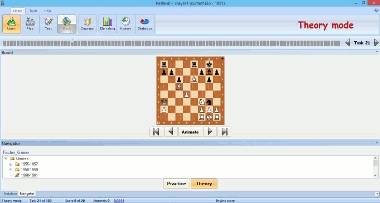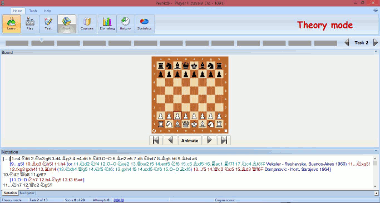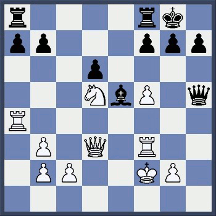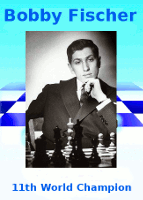Fischer Games and Puzzles
by Steve Goldberg
Bobby Fischer: 11th World Champion, by ChessOK, Figurine Algebraic Notation, Download, $19.95 (ChessCafe Price: $17.97)
Bobby Fischer: 11th World Champion is a downloadable course designed for the free Peshka graphical interface. For those users who would like to try it out, the Peshka program comes preloaded with a free training course called Play Like Botvinnik.
Those who have some familiarity with this ChessOK software will be able to quickly launch into this program. Others will likely require some time before they feel comfortable with the various controls. While there is a user guide available, I suspect most users will navigate around on their own until they figure things out.
The first thing I would advise is to make sure the screen is maximized. Otherwise, it is possible to miss some features of the program.I wish I had realized this sooner rather than later.

The menu bar at the top left of the screen is the basic starting point. Most users will likely focus on the first three options: Learn, Play, and Test.
When the Learn button is selected, two buttons at the bottom left are available: Notation and Navigator. In addition, when Navigator is selected, two other options appear: Practice and Theory.

The Practice button allows the user to work on various problem positions presented from Fischer’s games. Clicking the Notation button shows the moves once the problem is solved.
Pressing the Theory button provides access to Fischer’s games. Each game can be examined at the user’s leisure, or it can be “animated,” where each move is made automatically (users can control the speed at which this occurs). Pressing the Notation button while in Theory mode shows the game moves, and the annotation notes when they are present.
A total of 946 Fischer games are included, in more or less chronological order. The first games are from 1955, while the last are from Fischer’s infamous 1992 match with Spassky. 217 of the games are annotated, mostly in Informant-style symbols, with very little text. On occasion, the annotations include references to related game snippets.

To the right of the Learn button is the Play option. Clicking this button allows the user to play out the position against the built-in engine from the last position shown in the program.
The next button, Test, displays a series of positions, one at a time, for the player to solve. At times, the solution is shown too quickly, but the speed of moves can be modified by clicking the Tools button above the Menu bar, and then selecting Options. It was not clear to me how to return to a given test position if the user wants to review it again.
Between the Practice and the Test positions, there appear to be approximately 130 exercises in total. Since they have been selected from Fischer’s games, there are a number of tactical gems among these exercises. Here is one:
White to move

[FEN “r4rk1/pp3ppp/3p4/3NbP1q/R7/1P1Q1R2/1PP2KP1/8 w – – 21”]
Again, with the Learn button selected, and the Theory button clicked, one can proceed through Fischer’s games. They are divided into various periods:
- 1955-1957
- 1958-1959
- 1960-1961
- 1962-1963
- 1964-1965
- 1966-1968
- 1969-1971
- 1972-1992
This allows the user to select the general time frame desired. In Notation mode, the games can be scanned through fairly quickly using the Task button. However, there does not appear to be an easy way to select a specific game, other than moving through them one at a time until it is located.
On the menu bar, there are also options titled Elo rating, History, and Statistics. These provide a bevy of statistical reports, based on how well the user performed on the various practice and test positions. It is a bit of a mystery, however, how the program chooses to grade the user’s solutions.
Users who take the time to learn the quirks of the ChessOK program will likely enjoy the many problems included, and may even be able to decipher the multiple statistical reports. It can also be instructive entering Play mode and playing out interesting positions.
The publisher suggests Bobby Fischer: 11th World Champion is suitable for players rated between 1700 and 2300, but this is a very broad range. I suggest players between about 1400 and 1800 might most appreciate this software. Other products in this series include Alexander Alekhine: 4th World Champion, Mikhail Tal: 8th World Champion, Boris Spassky: 10th World Champion, and Garry Kasparov: 13th World Champion.
My assessment of this product: ![]()
Order Bobby Fischer: 11th World Champion
by ChessOK
A PDF file of this week’s review, along with all previous product reviews, is available in the ChessCafe.com Archives.

Leave a Reply